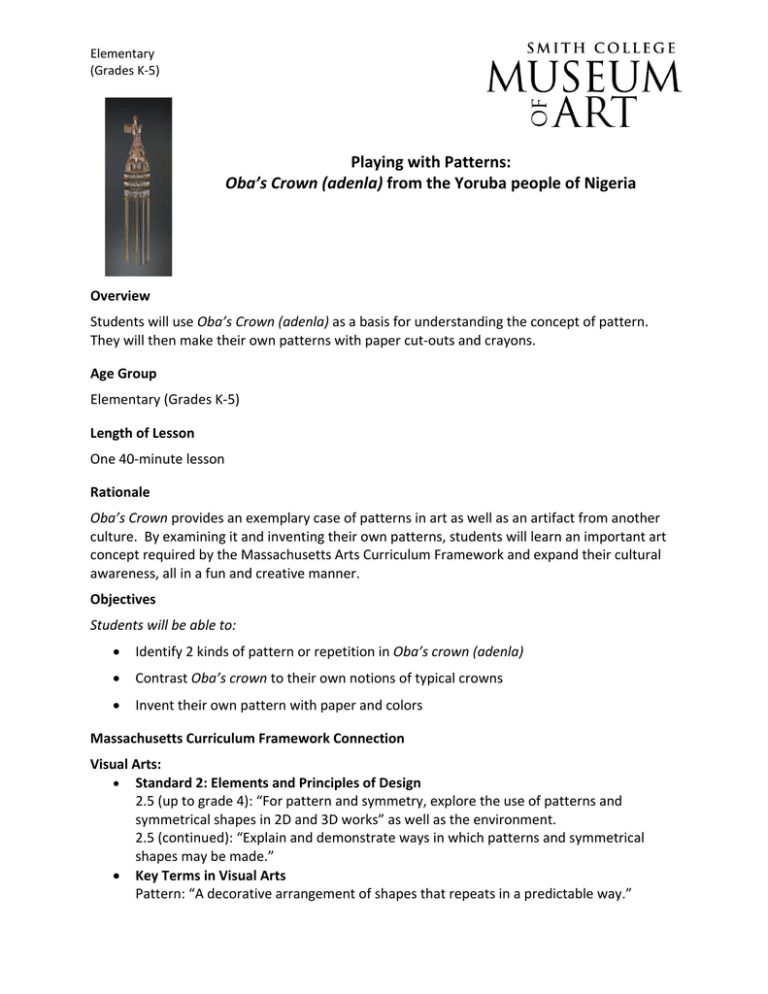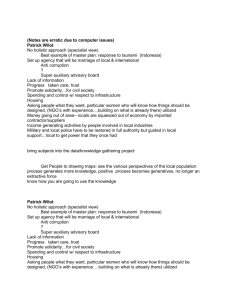Playing with Patterns: Oba’s Crown (adenla)
advertisement

Elementary (Grades K-5) Playing with Patterns: Oba’s Crown (adenla) from the Yoruba people of Nigeria Overview Students will use Oba’s Crown (adenla) as a basis for understanding the concept of pattern. They will then make their own patterns with paper cut-outs and crayons. Age Group Elementary (Grades K-5) Length of Lesson One 40-minute lesson Rationale Oba’s Crown provides an exemplary case of patterns in art as well as an artifact from another culture. By examining it and inventing their own patterns, students will learn an important art concept required by the Massachusetts Arts Curriculum Framework and expand their cultural awareness, all in a fun and creative manner. Objectives Students will be able to: • Identify 2 kinds of pattern or repetition in Oba’s crown (adenla) • Contrast Oba’s crown to their own notions of typical crowns • Invent their own pattern with paper and colors Massachusetts Curriculum Framework Connection Visual Arts: • Standard 2: Elements and Principles of Design 2.5 (up to grade 4): “For pattern and symmetry, explore the use of patterns and symmetrical shapes in 2D and 3D works” as well as the environment. 2.5 (continued): “Explain and demonstrate ways in which patterns and symmetrical shapes may be made.” • Key Terms in Visual Arts Pattern: “A decorative arrangement of shapes that repeats in a predictable way.” Elementary (Grades K-5) Page |2 Materials • Images of Oba’s Crown (adenla) and a way to display it to the class (or 1 color copy for every 4 students) • Colored construction paper • Coloring utensils such as crayons, markers, or colored pencils • Scissors • Glue sticks Lesson 1. Warm up: Ask students, what is a pattern? Help them come up with a working definition and write it on the board. Identify patterns on the students’ clothes, on upholstery, and around the room. What kind of patterns do you like? What do you like about them? o Definition (from Mass Curriculum Framework): a decorative arrangement of shapes that repeat in a predictable way. 2. Display Oba’s crown (adenla) to the class. What do they think it is? (A hat of some kind.) Explain that this was a king’s crown. Have you seen a picture of a king’s crown before? How does this one compare? Explain how it was worn (the veil of beads over the eyes) and where. If possible, show a map of Africa and point out Nigeria. Briefly discuss kingship: what do kings do? Why do you think they need crowns? (To show everyone that they are king and in charge.) Try to help students appreciate that, although this may not look like crowns they have seen, the Yoruba would recognize it immediately. If appropriate, discuss the symbolism of the eyes and the bird, and how they suggest that a king sees everything (see About the Art). 3. Discuss patterns in the adenla. Give students a few seconds to look, and then have each point out a pattern or some kind of repetition. Let each student mention one thing. Consider patterns, color repetition, the pattern in the veil, etc. 4. Hands-on project: Hand out paper and scissors. Tell students they’re going to make and draw their own patterns. Show them how to fold the paper in quarters or eighths and then cut patterns. Let students practice, then hand out more paper, the coloring utensils, and glue sticks. Invite students to invent their own patterns, either by cutting, coloring, or by gluing the cut-out to more paper and coloring it in like a stencil. Encourage them to make geometrical patterns like Oba’s crown, and keep the image of Oba’s Crown displayed. 5. Call on students to come up and show their patterns to the class and explain what they did. Elementary (Grades K-5) Page |3 About the Art Oba’s Crown (adenla) by unknown artist (Yoruba people, Nigeria). 19th-20th century. Glass beads, plant fiber, cotton. Crown only: 14 x 8 1/2 x 9 in. Purchased with Director’s Discretionary Fund, SC 2002:7a,b,c. Smith College Museum of Art. The artist: A master of the Yoruba of Nigeria Many skilled Yoruba artists work with seed beads to create crowns, footstools, and other royal regalia. The profession is held by men in the community and often passed down through generations. Patrons commission beaded pieces, but while the patron can request specific designs, the bead artist will typically elaborate upon details within traditional parameters. In the case of Smith College’s adenla, the artist used his imagination to design a crown whose visual spectacle celebrates the king’s authority (ase) while also demonstrating the artist’s imagination and technical skill. The intricate patterns on this adenla suggest the hand of a master artist. The work: Oba’s Crown (adenla) Yoruba kings are called obas, and they often collect both local and imported beads and control the distribution and use of the beads. Owning large quantities of beads and exquisite beaded clothing and regalia distinguishes the oba from the rest of the population. The ruler’s right to display these items displays his power within the society. Only kings can wear a beaded crown and veil like an adenla, which is characterized by its conical shape, the veil of beads that cover the face, an abstract face on the conical portion, and one or more birds at the peak. The adenla is worn only for rituals during the annual cycle of festivals when the king appears in public. It is always topped by a bird or cluster of birds, alluding to the spiritual realm. When the oba wears the adenla, he acts as a mediator between the realms of the physical, human world and the spiritual world. Birds also signify “our mothers” or the divine inner power of women to create life and give birth. The human-like faces on the crown represent ancestors (often Oduduwa, the mythical ancestor of all Yoruba). The veil hides the oba’s identity, so the attention is drawn to the crown, not the man. On Smith College’s adenla, the six embossed faces share a similar geometric design, composed of parallel lines of beads set at different angles. Each face is distinct, but the patterns blend into each other. The effect is an eerie sense of being watched, as faces morph into one another and confront the viewer from every angle. They suggest that an oba can see in many directions and his vision transcends that of ordinary mortals. This crown is called Soludero, which means “Bring Peace.” It was made for Oba Edun, who reigned over some of the Yoruba in the second quarter of the 19th century. “Edun” refers to the spot-nosed monkey, which the Yoruba associate with twins (ibeji). The Yoruba believe that twins possess spiritual powers and bring blessings to the family if properly cared for in life and in death. It is rare, but not unknown, for an oba to be a twin—such a person would bring wealth and good fortune to a community. Page |4 © Smith College Museum of Art © Smith College Museum of Art © Smith College Museum of Art Elementary (Grades K-5) Oba’s Crown (adenla) by unknown artist (Yoruba people, Nigeria). 19th-20th century. Glass beads, plant fiber, cotton. Crown only: 14 x 8 1/2 x 9 in. Purchased with Director’s Discretionary Fund, SC 2002:7a,b,c. Smith College Museum of Art. This work of art may not be currently on display at the Museum.






